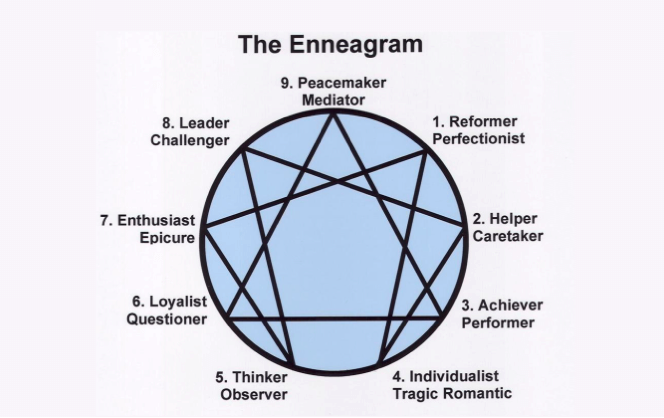Personalities and types of leadership
Becoming conscious Leaders through Personalities in Enneagram
Great leaders like Mahatma Gandhi, Martin Luther King, Nelson Mandela and others undertook a journey of self-knowledge to become the best version of themselves.
When we talk about leadership, we are implicitly talking about personality types or personal qualities. These are the inner resources that we have as human beings and that influence our own lives and the lives of those around us.
We can consider anyone to be a leader who has transcended the social conditioning in which they were born and who contributes to the enrichment of a society that is in constantly need of change and growth for future generations. All of this is done out of their own authenticity.
There are many different types of leadership that we will discuss in this article, but it is important to first differentiate between a leader and a boss.
A conscious leader vs. an unconscious boss
How can you distinguish a conscious leader from an unconscious boss?
An unconscious boss is someone who is in a position of responsibility or leadership but is still conditioned by the past. An unconscious boss is largely oblivious of the needs or ideas of others, has little self-awareness, and is not motivated by a personal vision that can touch or inspire others. The unconscious boss’ motivation is centred on himself and the fear of losing what he or she has. In practice, this means doing whatever others (superiors) expect. He or she is authoritarian and usually works through punishment. In the modern era of knowledge, this type of boss no longer fulfils the role that companies need when faced with the emergence of a new society through global crises in numerous areas: health, education, politics, economics, social etc. Our society necessitates a new mentality and makes it urgent for us to new ways of living a more fulfilling life on our planet.
Conscious leaders, on the other hand, know how to get the best out of others because they have first learned to deal with themselves. They have questioned their links to the past and have transcended them, they are connected to their humanity and their emotions, and are sensitive to their environment and able to respond to its needs. They understand that leadership is an act of service to improve society and take responsibility for themselves without blaming others in the face of difficulties. Instead, they find new ways to solve challenges. Conscious leaders are aware of their fears and know how to confront them and use them to their full potential. They have a healthy self-esteem, know their own value, and are aware of the contribution they can make as individuals. They indirectly inspire others with their vision and, because they understand human needs, they give room for feelings and emotions. They’re aware that mistakes are part of a learning process, and are able to move beyond the beaten path when they feel that it no longer meets their needs. They are prepared to risk innovation and explore and discover new alternatives.
Nowadays, companies need people who know themselves. Self-awareness is one of the key elements for success, as our main challenge is learning how to deal with ourselves and with others. This self-knowledge will allow us to develop our talent and creativity and increase our potential. A conscious leader will help others to grow and to trust themselves by setting a good example. He or she knows how to see the unique gifts of others and how to take advantage of these.
Enneagram and leadership
We have known about the enneagram since the beginning of the 20th century from a Sufi master called Gurdieff. Nowadays, the enneagram has become a powerful tool for self-knowledge in psychology and business coaching, amongst other things. Through the study of the enneagram we can become aware of the mechanisms that shape our personality and discover a way to transcend our limitations and fears by getting in contact with our authentic self, where the true potential for conscious and genuine leadership resides.
The enneagram shows us that our personality is a construction of a false ego from early childhood, a natural process of adaptation to our society. The development of this personality began with a main wound or desire, from which the entire structure of our character was forged over subsequent years. This wound should be the main topic of self-discovery in our lives, and it will be our main challenge to overcome and transcend. It is therefore of vital importance.
The wound will have been installed in us by the acceptance of a limiting belief at an early stage, the result of our relationship with our environment. This belief will have originally helped us to adapt, but it later became a limitation and contains internal suffering that we must recognise and transcend if we are to recover the essential truth about what we are and what we can achieve. The enneagram outlines 9 types of wounds on which any personality is unconsciously developed.
There 9 wounds correspond to 9 types of personalities. They are all related to each other through a diagram of self-knowledge that represents our own journey towards personal discovery.
 Picture from: https://personalityjunkie.com/10/enneagram-type-7-7w6-7w8-enfp-entp-esfp-estp/
Picture from: https://personalityjunkie.com/10/enneagram-type-7-7w6-7w8-enfp-entp-esfp-estp/
As we become aware of ourselves, we become a type of potential leader. We will briefly look at the types of leaders that emerge from the different characters proposed by the enneagram.
The personalities in the enneagram can be classified into 3 main groups, each indicating where the nuclear wound of the character originated. These three groups of character are: the visceral, the emotional and the intellectual.
In the VISCERAL personalities, the wound of the ego is based on a conflict in its capacity to act. These personalities have felt a lack of autonomy and independence at a given moment that has led to a lack of serenity in their character. They are impulsive and react easil. They are quick to act. The most predominant emotions in this type of character are anger and rage.
The character type 1 is the perfectionist. The limiting belief from childhood is “only if I am perfect am I worthy of love”. This character is reactive and critical, too much involved in operational details, inflexible and dogmatic. When this character learns to delegate without constantly checking up on others, the wound is transformed into wisdom and this character finds the perfection they long for all around them. They then become a Visionary Leader. They lead through example, organisation, consistency, responsibility, pragmatism, and attention to detail.
Character type 9 is the peacemaker, whose limiting belief is “to be loved, I have to be complacent and sacrifice for others.” This character is normally unassertive, avoids conflicts, looks for accommodation, is indecisive and has low energy. Once they transcend this belief, they become a Participatory Leader. They lead through diplomacy, inclusiveness, patience, respect for others, consensus and consistency.
Character 8 is the Asserter type, whose limiting belief is “others are going to hurt me, it’s better not to trust anyone so I don’t have to suffer disappointment”. This character is controlling and demanding, agitated and often displays a bad attitude. Once this belief is transcended, they can become a Fair Leader. They lead through a strategic vision, understand the influence of a network, are honest, bold, courageous and active.
In EMOTIONAL personalities, the trauma or wound is in the emotional plane, found in a lack of self-esteem or approval of others. These personalities feel a lack of love and recognition.
The type 2 character is the Helper, whose limiting belief is “I am worthy to be loved if I help others and show I’m special”. They are much too focused and involved in relationships, have difficulty in saying no or setting boundaries. Once the wound is healed they can become a Helpful Leader who leads through motivation, develops excellent relationships, is supportive and has a lot of inner emotional resources.
The character type 3 is the Motivator, whose nuclear wound is “my value depends on the recognition of others.” This character is too competitive, abrupt in stress situations, impatient with long conversations, and often overworks. Once the wound is transformed and its internal value is acknowledged, this character can become an Entrepreneur Leader who leads through clear goals, is focussed, has an entrepreneurial spirit and a lot of energy, and transmits a “can-do” attitude.
The character type 4 is the artistic, whose wound is to feel that “others are worth more than me and make things better, so I don’t deserve to be happy or loved.” This character is too intense or moody, over-emphasizes feelings, is over-sensitive and withdrawn. This wound can be transformed to create a Creative Leader who leads through a vision that is value-based, creative, inspirational, compassionate and emotionally connected to others.
In the INTELLECTUAL personalities, the wound is established in the mental plane through a lack of self-confidence that generates a feeling of fear and insecurity.
Character type 5 is the Thinker, whose wound is “I do not need anything from anyone, loneliness is my refuge. If I show myself, they’ll damage me”. This character is detached, remote or aloof, very independent, doesn’t feel comfortable engaging with others, and is too cerebral. Once it fulfils its potential it can become an Innovative Leader who leads through research and planning, is logical in insights and analysis, is objective and becomes an expert on a single topic.
The character type 6 is the Loyalist, whose wound is to think that he cannot trust himself: “The world is a dangerous place, I have to protect myself from it”. This character is too wary and cautious or takes too many risks, is too compliant or too defiant, and normally projects his feelings and thoughts onto others. Once he acquires confidence in himself, he can become a Courageous Leader who leads through collaboration, is creative and oriented towards solving problems, is good at assessing possible risky situations, is loyal and perseveres.
The character type 7 is the Enthusiast, whose wound is thinking that suffering is useless: “It’s better to enjoy, laugh and flee from conflicts, rather than experience pain”. This character is impulsive and unfocused, avoids difficult issues, is very rational, and lacks the ability to follow through on tasks. Once it begins to accept that pain is part of life, it is transformed into a Happy Leader who leads through innovation, has a lot of energy, is full of new ideas, is enthusiastic, curious, and able to engage with others.
The wound of each character hides an enormous potential for growth, like the roots of a tree that provide the necessary depth for the top to rise up to the sky. The limitation and suffering inherent in human existence is an opportunity for transformation and provides enormous potential for wisdom and fulfilment that can be found through self-knowledge.
Throughout human history, wise men from all different periods have expressed throughout diverse cultures and geographical locations the importance of self-knowledge in our lives. One such piece of wisdom has been engraved in the temple of Delphos in Greece: “Know yourself, and you will know the universe and the gods”.
The enneagram is a wise map of self-knowledge, a manual that helps us to understand the human character and shows us how a character can become unbalanced. It indicates the path we need to follow if we are to heal and transcend our wound and rediscover the richness of our true essence. It shows us the path back to ourselves, towards restoring our authenticity.
Bibliography
- Margaret Frings Keyes (1993). Emotions and the enneagram. Working Through Your Shadow Life Script. Ed. Molysdatur
- C. Naranjo (1994). Character and Neurosis: An integrative view. Ed. Gateways Books
- Don Richard Riso (1990). understanding the enneagram: the practical guide to personality typesed. Ed. Houghton Mifflin Harcourt.
- Michael J. Goldberg (1996). Getting Your Boss’s Number: And Many Other Ways to Use the Enneagram at Work
Laura Lopez Gámez
 I am a psychologist with great experience as trainer in Humanistic approaches; on Body movement and Corporal Expression (Río Abierto), Vital Readjustment facilitator, MBSR in Mindfulness and Gestalt therapy. I work mainly in the areas of Conflict Resolution, Emotional Intelligence, and Leadership with holistic practices that bring self-alignment.
I am a psychologist with great experience as trainer in Humanistic approaches; on Body movement and Corporal Expression (Río Abierto), Vital Readjustment facilitator, MBSR in Mindfulness and Gestalt therapy. I work mainly in the areas of Conflict Resolution, Emotional Intelligence, and Leadership with holistic practices that bring self-alignment.


